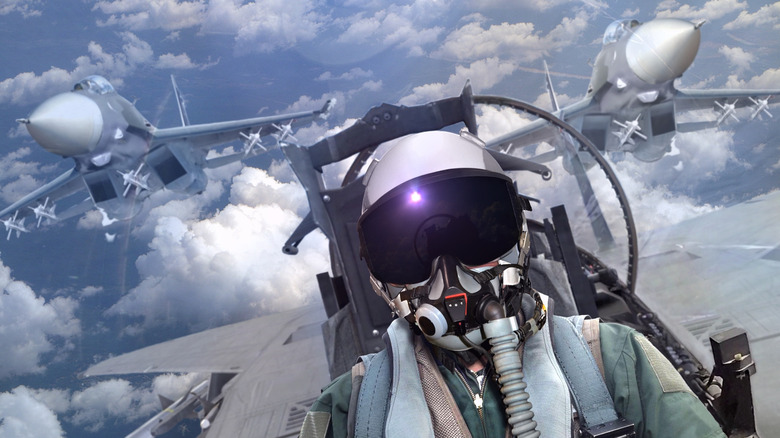
Soaring above the battlefield, fighter jets make their presence known in a massive way. Evolving from the machine gun-toting dogfighters of the World Wars, fighter planes offer versatile aerial toolkits, engaging in bombing missions, surveillance and electronic warfare tasks, and much more. Of course, these fighter jets are still equipped with plenty of firepower to handle air-to-air combat roles, too.
While the modern fighter aircraft may do less dogfighting and more multi-role air superiority when
deployed, that doesn't mean that crucial weapons systems have become any less capable. In fact, plenty of cutting edge fighters carry weapons payloads that are truly eye watering. From gun turrets to missiles and bombs, fighter jets carry an array of munitions that make them deadly in a barrage of different ways. Fast, lethal, and well-armed, the race to the top in this arena is a game of inches, with each country and manufacturer looking to enhance their capabilities in full spectrum ways every time they develop and deploy a new fighter system. The jets carrying the highest weapons payloads frequently wear the U.S. flag on their frame, but many other countries have produced immensely capable and highly weaponized aerial tools, too. These are the 13 fighter jets across the world that can carry the greatest total volume of weaponry, starting at the bottom of the list.
Read more: 10 Airplanes That Managed To Fly With Staggeringly Low Horsepower
Saab 37 Viggen
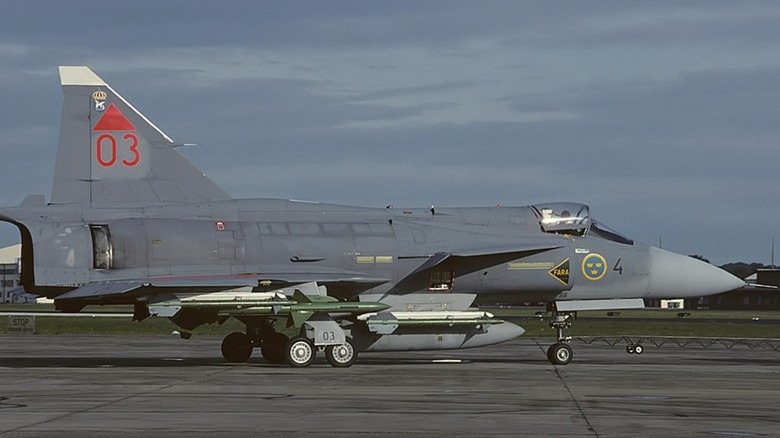
The Saab 37 Viggen fighter jet was first produced starting in the 1970s, and it remained a major tool in the Swedish military into the 2000s. The 37 Viggen exists with a notable gulf between its combat arms figures and the next highest offering, but that doesn't mean it wasn't a major presence in the skies. The fighter jet first took off in 1967 and started its run of service in the Swedish military in 1971. The jet exhibited short take off and landing capabilities (STOL) largely on the back of its canard design, the first to utilize this tool in large production aircraft. This small, additional wing segment gives the 37 Viggen a unique silhouette that allows it to stand out from the pack, even today. The aircraft was capable of withstanding 12G forces and served in the Swedish air forces until 2005 in numerous multi-role requirements beyond its primary fighter designation.
The aircraft features a weapons payload capacity of 13,227 pounds. This gives it solid weaponry heft, but places it at the back of the pack for our purposes. However, this fighter deserves a special mention not for its role in aerial dogfights, but for an almost unbelievable interdiction capability. On numerous occasions, the JA-37 Viggen, piloted by Swedish forces, has intercepted SR-71 Blackbirds as they made their way across what was known as "The Baltic Express." The SR-71 is a legendary spy plane, and is known for its dizzying speeds and altitude ceiling, and anything capable of intercepting it is a standout, to be sure.
Eurofighter Typhoon
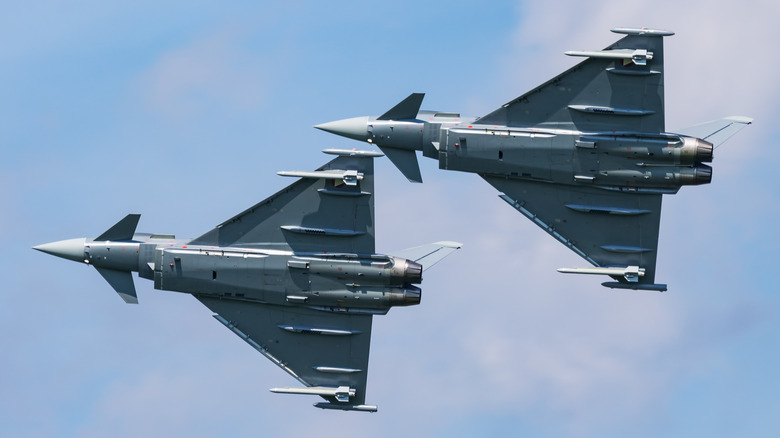
The Eurofighter Typhoon is a stealth solution designed as a European consortium effort. Italian, German, British, and Spanish coordination went into the design of the system that Eurofighter (the forward facing company building the jet) calls "the world's most advanced swing-role combat aircraft." Behind the scenes, government input and support from private players in the four countries' aerospace sectors (over 400 individual companies in total) came together to produce the Typhoon.
The fighter jet is underpinned by an array of sensors that help deliver air superiority performance and unveil a comprehensive picture of the battlefield that the jet is engaged within for allies on the ground and friendly fliers alike. The Typhoon can carry a range of armaments and is considered a fifth generation fighter-bomber. There are approximately 165 in service today, with its entry into official duties coming in 2003. The jet can carry a maximum ordinance load of 16,500 pounds with a total cap on its payload rated at 27,800 pounds (with additions like fuel and support systems loaded onboard). It offers a service ceiling of 65,000 feet and a maximum speed of 1,550 mph. Add in the jet's 13 total hardpoints and it's a competitive multi-role option that can serve in numerous tasks with ease.
Sukhoi Su-30 Flanker
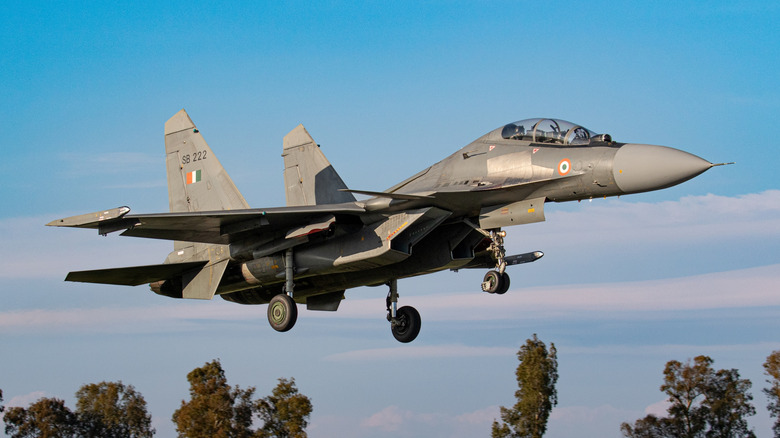
The Sukhoi Su-30 (known within the NATO classification system as "Flanker") first took to the skies in 2012 and features as a multi-role fighter jet in the Russian Air Force and Navy, as well as in Kazakhstan's Air Force. Su-30MK variants can also be seen flying Algerian, Angolan, Armenian, Chinese, and Indonesian colors, among numerous others. The Su-30 is built to accommodate a two-person flight crew and features advanced avionics to support a seamlessly modern experience in the air.
The fighter's most prominent weapons system is the Russian Oniks supersonic missiles. These are anti-ship and land-attack platforms that feature an operational range of just over 186 miles. In total, the jet can carry up to 17,637 pounds of weaponry, featuring a mix of missiles, cannon armaments, and bombs. It can also be outfitted with SAP-518 jamming pods to support electronic warfare operations or engage in multi-role combat on the fly.
Boeing F/A-18 Super Hornet
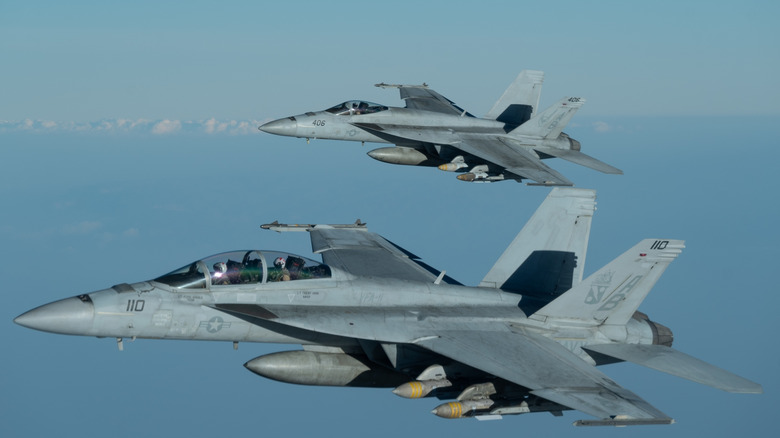
The F/A-18 Super Hornet was introduced in 1999 as a comprehensive upgrade to the existing "Hornet" build. The new model offered improved avionics to support more robust flight controls and maneuvering capabilities, more powerful engines, and of course, increased payload capacity. The third block of Super Hornet fighter jets began deliver to the U.S. military in 2021, featuring enhancements to the cockpit display as well as the jet's computational processes that make it even more advanced in adversary identification and targeting processes on a broad scale. The aircraft serves the U.S. Navy as a carrier-based fighter performing multi-role operations. It's frequently deployed as a strike solution, but electronic warfare and reconnaissance missions are also a standard part of the aircraft's wheelhouse.
The fighter jet features an external payload of 17,750 pounds, but can also carry missiles and other weaponry systems internally, amplifying its base payload offering (including laser guided bombs). The Super Hornet features a mission range increase and endurance upgrade over the Hornet build by 41% and 50%, respectively, making it a huge force augmentation for the Navy's aerial warfare capabilities.
Mitsubishi F-2 Viper Zero
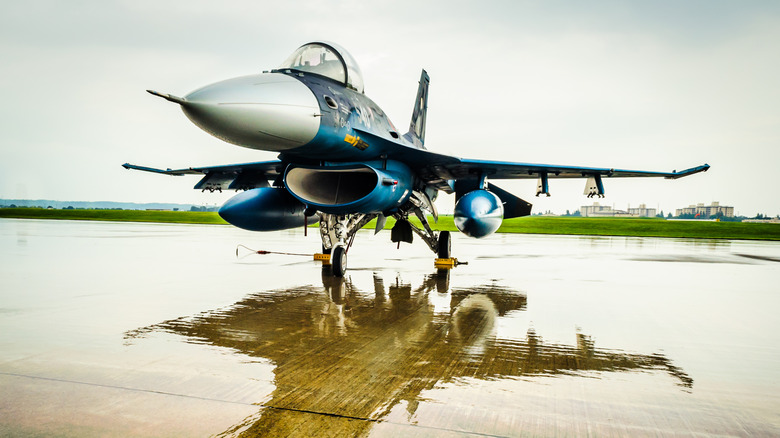
This Japanese fighter jet is based on the much-respected F-16 platform. It features a specialized wing construction that enables lighter builds while retaining key structural integrity, and high tech avionics to support a mobile and competent aerial fighter platform that can hold its own in numerous combat situations. The F-2 Viper Zero entered service in 2000, and 94 examples (in addition to four prototype models) were built between 1995 and 2011.
The aircraft is only used by the Japanese Air Self-Defense Force and was delivered in two variants. The F-2A is a single seat build, with most conforming to this design language. The F-2B is largely the same overall but with a reduced fuel load and tandem seating. The aircraft takes its nickname from a mashup of the "viper" moniker given to the F-16 and the Mitsubishi A6M Zero, perhaps Japan's most recognizable historical fighter jet. It's capable of loading up with a maximum weapons payload of 17,820 pounds.
Shenyang J-35
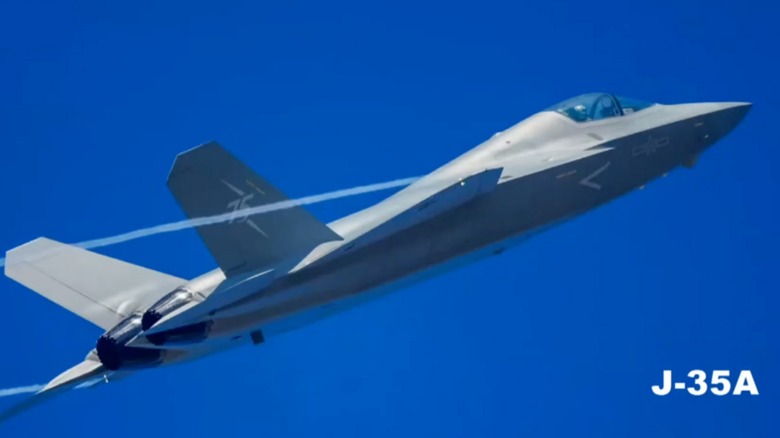
China's Shenyang J-35 has only recently been delivered for service in the country's Navy. Images of naval insignias adorning the tail segments on two J-35s made the rounds on July 18, 2025, although speculation as to whether the aircraft are legitimate production models or reskinned prototypes aimed at spreading disinformation remains in effect this early on. The J-35 elevates China's fifth generation fighter jet program, bringing it nominally in line with the United States' two fighters classified under this designation (to Russia's single offering, albeit with some major flaws in tow).
The J-35 is equipped with short range missiles and long range options, and it can perform bombing functions or attack sea-based targets, too. It can handle a total weapons payload of roughly 18,000 pounds across internal bays and under-wing hardpoints. It's a stealth fighter that can also carry anti-radiation missiles designed to disrupt radar systems, and it's thought that the fighter may also be rolled into anti-submarine operations as well, once it's been fully deployed within the Chinese naval environment.
Lockheed Martin F-35 Lightning II
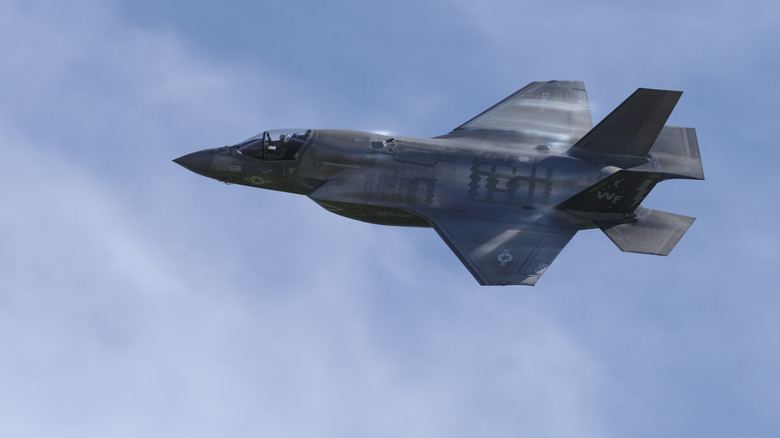
The F-35 Lightning II from Lockheed Martin is a virtual shoe-in on just about any list of fighter jets. No matter the topic, this aerial combat tool is likely designed with the feature integrated into its framework. The F-35 is the U.S. military's next-generation fighter jet, and one that spent many years in development and production. It's a somewhat controversial aircraft for this reason, but the technological leap forward that the F-35 brings to the table is undeniable. This is simply one of the most stunning feats of aerospace engineering to ever roll off the production line.
The fighter jet is considered the most lethal aircraft in the world, and excels as a result of its immense volume of technological advancements. The aircraft is a one-stop-shop for data processing. Its sensor array and battlefield awareness features give it the edge over virtually anything that might be flying in opposition. Even with a payload ranging in the middle of the pack among heavily armed fighter jets (at 18,000 pounds), the F-35 is ahead of the curve when it comes to aerial showdowns, both in close combat operations and extended air superiority roles.
McDonnell Douglas F-4 Phantom II
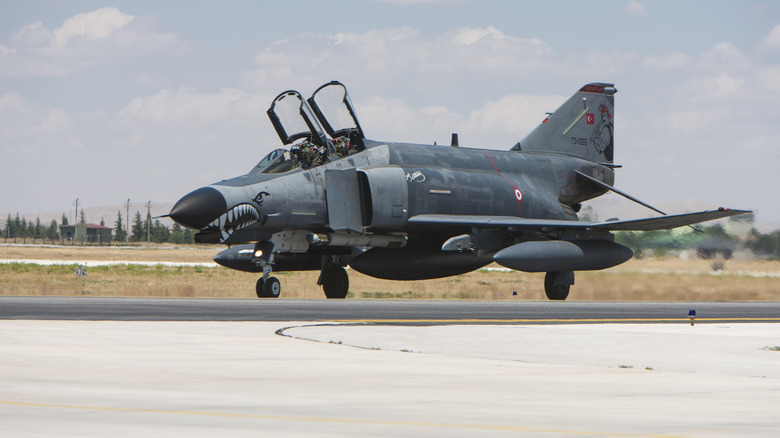
Nearly 5,200 McDonnell Douglas F-4 Phantom II fighter jets were built during its production window, from 1958 to 1981. It remains in service to this day, standing as a testament to immensely capable aircraft design and incredible performance metrics. The fighter jet can reach a top speed above Mach 2.23 (1,472 mph), making the F-4 Phantom ludicrously fast when the need arises. It can carry 18,500 pounds of munitions, including air-to-air missiles, air-to-ground weapons, and bombs. The original build did not include a machine gun, but an M61 rotary cannon was later added to some models.
The F-4 Phantom II is one of the American jets that played pivotal role in the Vietnam War, in particular. The aircraft was an excellent aerial fighter that notched more than 100 victories in dogfights with MiG jets. It was heavily armed and fast all at once, making it a significant threat to ground troops battling American forces and their aerial support flying overhead. The F-4 was the first fighter jet to be used by the Navy, Marine Corps, and Air Force simultaneously, and once served as the platform of choice for both the Air Force's Thunderbirds and the Navy's Blue Angels (the only aircraft to earn this honor).
Mikoyan MiG-31 Foxhound
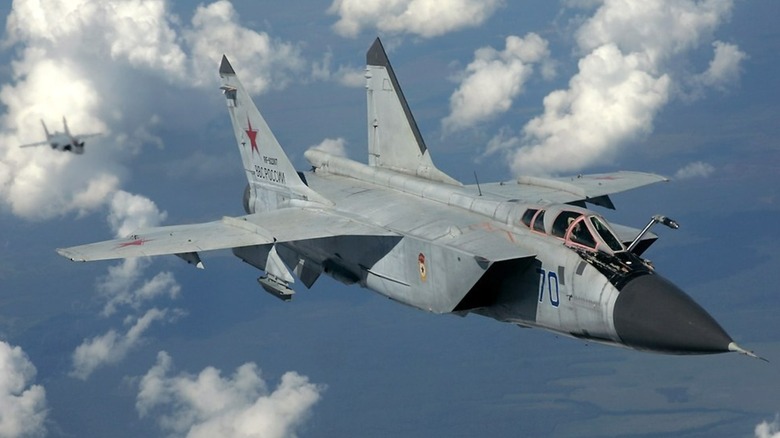
The MiG-31 (NATO designation "Foxhound) is one of the fastest fighter jets ever produced. It first entered service for the Soviet Air Force in 1981 and over 500 were built. The jet can reach a top speed of 1,900 mph under ideal flying conditions and carry a full compliment of arms weighing up to 20,000 pounds when necessary (although these two points absolutely run contrary to one another).
Today, the Kazakh Air Force flies MiG-31 models, and in 2009 there were plans to deliver eight to Syria, but that contract was ultimately canceled. The jet was built largely on the same basic framework as its predecessor, the MiG-25. However, a number of important upgrades were required of the newer model. For starters, the MiG-25 was not able to handle flight at low altitude, and improved turbofan engines were fabricated for the MiG-31 to enable not only consistent flight performance at lower ceilings, but also supersonic capability at these altitudes. It also received the first electronically scanned phased array radar that could scan a distance of up to 200 kilometers and track up to ten targets at one time.
Dassault Rafale
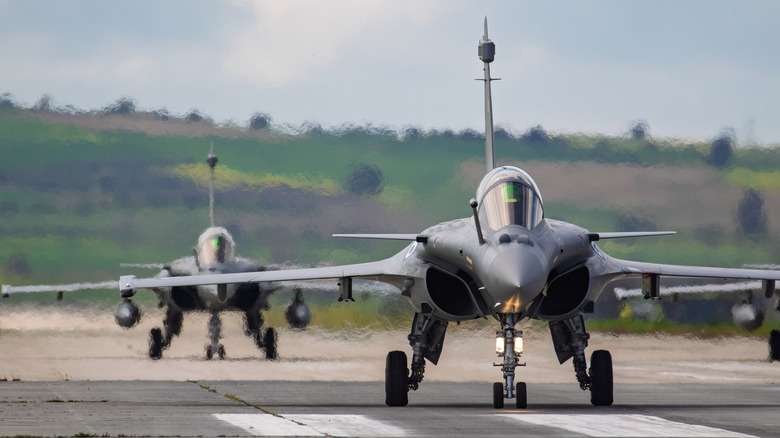
The French Dassault Rafale can carry 21,000 pounds of weaponry as it takes to the skies. The fighter exhibits a service ceiling rated at 50,000 feet and can reach speeds of Mach 1.8. The jet features small canard wings, augmenting its sleek silhouette in a major way. The jet first flew in 2004 in service to the French Navy and in 2006 as a French Air Force fighter, and engaging in direct combat in 2007. It offers both ground and ship-based operations, performing what Dassault calls an "omnirole" air superiority task.
Interestingly, the Rafale has become primarily an export solution, with more foreign orders of the jet than domestic ones. Even so, the tool has been the target of Chinese disinformation campaigns recently, aiming to hurt the French jet's reputation among new and repeat potential buyers. The fighter jet features a battery of high tech sensor equipment to identify and outmaneuver an adversarial presence before close contact is made. Its onboard data fusion capabilities help speed along decision making tasks to place the jet and its pilot (or pilots, in a two-seat variant) in an advantageous position at all times.
Sukhoi Su-57 Felon
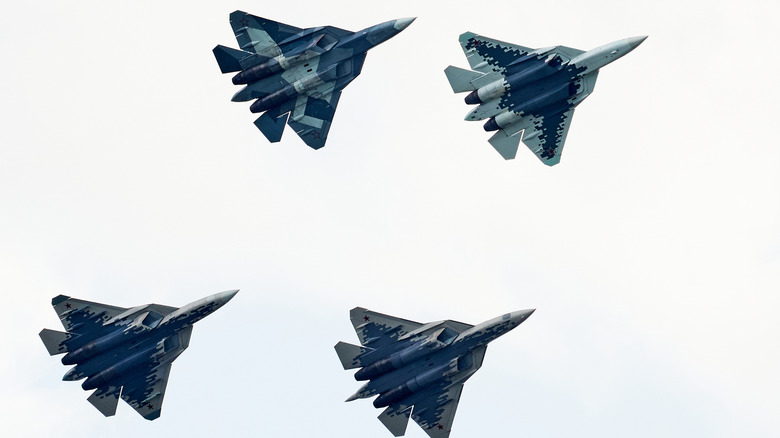
The Sukhoi Su-57 (NATO designation: "Felon") first flew in 2010 and stands as Russia's fifth generation multi-role fighter platform. It can carry a total weapons payload of 22,000 pounds. The Felon is a problematic aircraft, however. It appears to have a similar profile to fourth-generation fighters when spotted on radar, and seemingly lacks the typical fifth-generation technology for minimizing detection. This places it as a distant afterthought behind the modern American and Chinese fighters of late. The Su-57E has also been a commercial export flop, relegating the tool essentially to just domestic use.
On the plus side, the Su-57 lives up to Russia's commitment to "supermaneuverability." The aircraft is just one of a handful of jets that can perform the Pugachev's Cobra. The move is undoubtedly one of the coolest high-tech features to ever make its way into fighter jet design. This makes it a chilling adversary to encounter in an aerial dogfight, but lacking in technical precision to handle distant air-to-air standoffs.
Chengdu J-20 Mighty Dragon
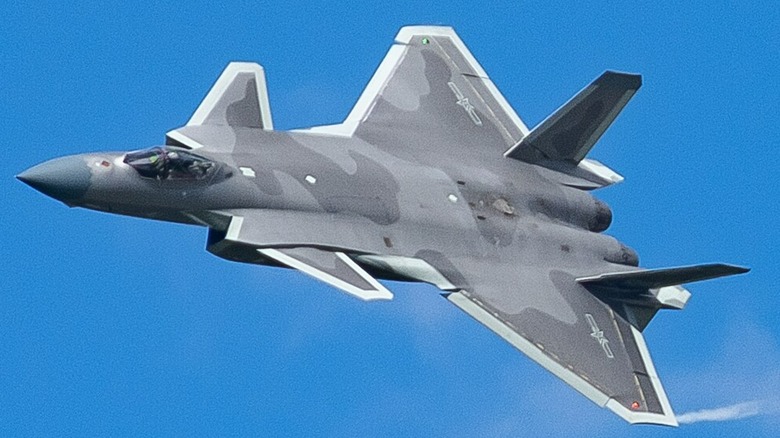
The chip war is an economic struggle with wide ranging ramifications. High tech chip production underpins breakthroughs in the consumer marketplace, but the battle for supremacy in this space focuses on a different application. Cutting edge semiconductors feature as the beating heart of any modern battlefield's most lethal tools.
One such weapon of war is the Chengdu J-20 Mighty Dragon, China's preeminent stealth fighter. The fifth-generation fighter jet is jammed full of impressive technology, and China's contemporary research into processing improvements have been poured directly into major upgrades for this aircraft, in particular.
National Security Journal called the J-20's most recent breakthrough "a big fighter upgrade" thanks to improvements in the production of high purity semi-insulating silicon carbide semiconductor crystals. Domestic research within China's university system has yielded a unique jump in productive capabilities, ultimately expanding significantly on the detection range (by three times) and missile targeting capabilities of the fighter platform. It also stands poised to deliver high powered laser solutions that could further revolutionize the jet's lethality. These features expand greatly upon an already formidable presence in the sky. The J-20 can carry a weapons payload of 26,000 pounds, placing it second on this list. It's not as swift in the air as some of its modern American counterparts, but long range weaponry and a huge focus on detection and situational awareness systems gives it a particularly hard edge, as does China's fleet of J-20s, thought to number around 300 at present.
Boeing F-15EX Eagle II
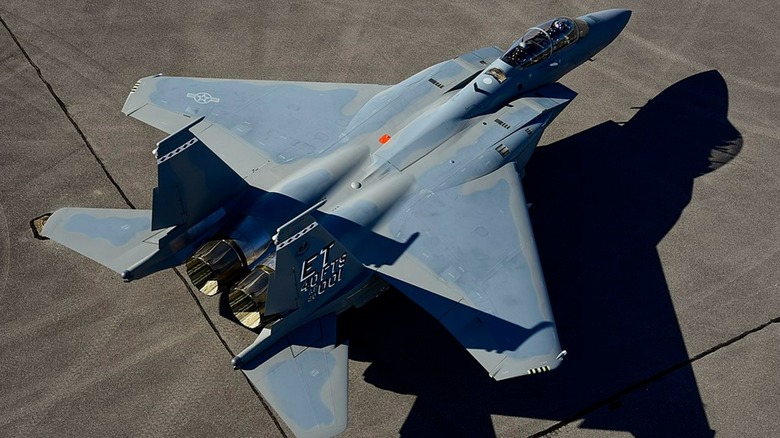
Armed with the greatest collective volume of weaponry among fighter jets, the Boeing F-15EX Eagle II is a marvel in the skies. It features advanced radar systems and compatibility with hypersonic weaponry. 12 AMRAAMs can be loaded onto the jet, or as a mix-and-match selection alongside other heavy weaponry, and even with a full loadout of deadly equipment, the aircraft doesn't sacrifice its stealthy frame. A hallmark of the fighter is its low detectability, a feature that's maintained even as additional armaments are brought onboard.
Its total payload is a genuinely astonishing, with a capacity of 29,500 pounds of weaponry available to the two-person flight crew. Even with its plethora of air supremacy functions and capabilities, the F-15EX Eagle II is a sort of patch in the long term planning of American military strategy. The Eagle II was a reconstitution of the McDonnell Douglas F-15E, and originally Boeing began building them as an export solution (with the F-15SA and QA models heading to Saudi Arabia and Qatar, respectively). However, a planned decommissioning of older jets heading into the 2010s alongside production snags of F-22s and F-35s led to the introduction of these "Generation 4.5" fighters. They come from an older framework, certainly, but integrate fifth generation sensor technology and many other improved assets that set the jet apart when it lifts off. The U.S. flies 98 of them today, with a plan to expand in the near future.
Want the latest in tech and auto trends? Subscribe to our free newsletter for the latest headlines, expert guides, and how-to tips, one email at a time.
Read the original article on SlashGear.











